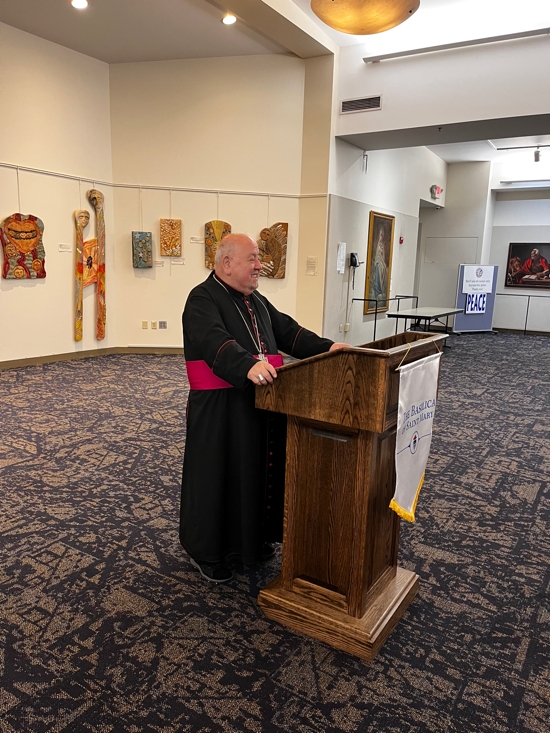
The persecution of Christians in Syria, such as the suicide bombing that killed 25 at a Damascus Orthodox church in June, is not common, said Archbishop Samir Nassar of the Maronite Catholic Archeparchy of Damascus at a June 26 talk at the Basilica of St. Mary in Minneapolis.
But as young people raised in the Maronite and other Eastern rite Catholic and Orthodox churches leave the war-torn country to find work or marry outside the faith, the Christian churches “are going down, collapsing really in the quiet of the night,” he told about 50 Basilica parishioners and supporters of the Archdiocese of St. Paul and Minneapolis’ eight-year partnership with the archeparchy.
An archeparchy is an Eastern Catholic ecclesiastical territory, equivalent to an archdiocese in the Latin (Western) Catholic Church. The Maronite Catholic Church, which dates to the fourth century, is one of 23 Eastern rite Catholic Churches, which along with the Latin Church, are in communion with the Holy See.
Archbishop Nassar’s talk in June was part of his third visit to the Twin Cities in support of the partnership, which was organized in 2017 by the Center for Mission in support of the archdiocese’s missionary efforts. The partnership connects the archdiocese’s patron, St. Paul, with the archeparchy in the city of Damascus. Damascus was where the saint was received and baptized after his conversion to Christianity before being sent forth as the “Apostle to the Gentiles,” according to a Center for Mission partnership brochure.
Archbishop Nassar praised the archdiocese’s recent Synod as “building a future,” while noting the diminishing Christian population in Damascus and other parts of Syria whose war-damaged cities still reveal the country’s glorious Christian past.
“We did have a very glorious history, but we have a very dark future,” he said, adding that the archdiocese, through the partnership, provides support, friendship and prayer that help Syrian Christians stay in their country.
Before the Syrian civil war in 2014, the country had 33,000 churches, he said. “Now we have some hundreds.”

Another reason young people are leaving Syria is that life there is difficult, Archbishop Nassar said. He said electricity is rationed and economic sanctions on the country have caused food, water and medicine shortages. (President Donald Trump signed an executive order revoking U.S. sanctions against Syria on June 30.)
Archbishop Nassar also noted that Christians who marry Muslims effectively leave the faith because they must convert to Islam.
“We are losing to marriage and we are losing to the war,” he said. “The young people, they want to leave.”
Those who stay may be older and find it more difficult to get the help they need, he said.
Christians are fearful in the wake of attacks such as the one during a liturgy at the Greek Orthodox Church of Mar Elias in Damascus on June 22 that killed at least 25 parishioners, but that attack may have been more politically motivated, Archbishop Nassar said.
It may have been intended to show the current provisional Syrian government formed on March 29 that it is not in control of the country, he said, adding that it may also be aimed at Russia, which has supported the Orthodox Church in Syria.
Along with the challenges, the Syrian Church is seeing positive signs in the solidarity of the family and a rise in vocations which is giving them courage to stay and defend themselves, Archbishop Nassar said.
Basilica parishioner David Rigert, 61, attended the talk because of his longstanding interest in the Middle East. He was concerned to learn about the drastic diminishing of Christians and churches. Rigert also wanted to know how Syria’s Muslim and Christian communities interact and whether the new Syrian government would be more receptive to all religions.
David Rigert’s wife, 53-year-old Miluska Rigert, said she attended the talk to connect with, and learn more about, people in other places. She said the talk inspired her to live her faith better in the United States and noted that Americans need Syrians’ prayers. “Even in the worst-case scenarios when they know they may die, they will die happily for our faith, for Jesus and they will leave everything.”
Archbishop Nassar asked for prayers from archdiocesan Catholics. Syrian Christians hope for the future, for peace and for a good relationship with their new government, he said.
“We are not persecuted,” Archbishop Nassar said. “There is something good in Syria … we are a church of martyrs. We don’t know how many martyrs.”
___________________________________________________________
DAMASCUS
PARTNERSHIP
A pilgrimage that began Jan. 25 in the Archdiocese of St. Paul and Minneapolis featured a Martyrs of Damascus relic and icon and honored the archdiocese’s partnership with the Maronite Catholic Archeparchy of Damascus in southwestern Syria. The pilgrimage began at St. Maron Maronite Catholic Church in Minneapolis on the feast of the Conversion of St. Paul. It concluded June 29 on the solemnity of Sts. Peter and Paul at the Cathedral of St. Paul in St. Paul, after visiting five other parishes this year, said Deacon Mickey Friesen, director of the Center for Mission, which organized the pilgrimage.
A first-class relic of one of the three Maronite Catholic laymen depicted in the icon — who were canonized by Pope Francis last October — and an icon of St. Paul’s baptism into the Church by St. Ananias, which also depicts the three martyrs, were included in the pilgrimage. The St. Paul icon, written by Stillwater-based iconographer and Orthodox Christian Deb Korluka, was completed in 2021. The Martyrs of Damascus icon was authored in Damascus.
The archdiocesan partnership with the Damascus archeparchy, which represents Catholics of the Eastern rite Maronite Catholic Church dating to the fourth century, was formalized in January 2017 by the Center for Mission in response to Archbishop Bernard Hebda’s call to assist Middle Eastern Christians facing increased suffering from war.
The partnership highlights St. Paul’s influence in the two locations: St. Paul is the archdiocese’s patron, and he was received and baptized in Damascus after his conversion to Christianity.
“We’re the only diocese named after St. Paul, and they’re named after Damascus,” Deacon Friesen said. “And so, we feel like this partnership is St. Paul returning to Damascus.”
Goals for the partnership, described as a “journey of faith,” include:
Sharing life and faith stories and prayer intentions throughout the year;
Building relationships;
Sharing resources in “small, simple and safe ways”; and
Deepening understanding of Eastern and Latin rite churches.
While anyone in the archdiocese can get involved in the privately funded partnership, parishioners at four or five parishes have been most active, including the Basilica of St. Mary, which hosted a talk by the Maronite Archeparchy’s Archbishop Samir Nassar on June 26, Deacon Friesen said.
In the next year, one partnership member is exploring the possibility of helping Syrian children address mental health issues resulting from the country’s 11 years of war, he said.
Since the partnership formed, Archbishop Nassar has been the archdiocese’s main contact with the archeparchy, and his scheduled retirement will start a new relationship with the next bishop, Deacon Friesen said.
Visit centerformission.org to learn more about the Damascus partnership.




